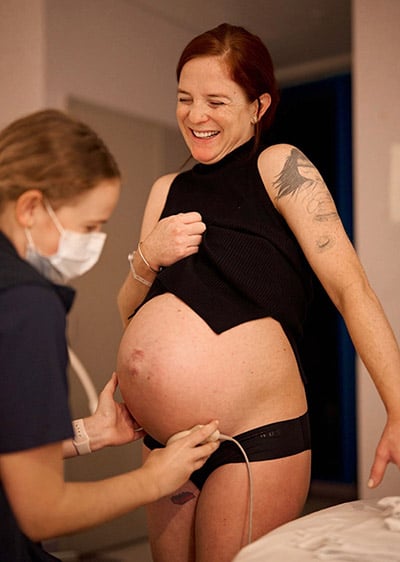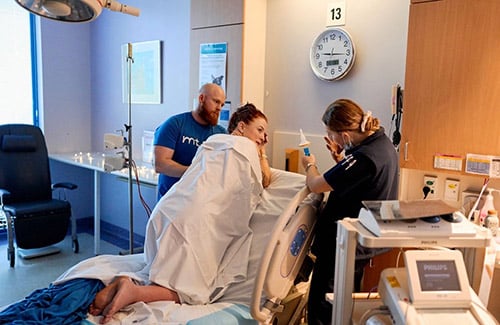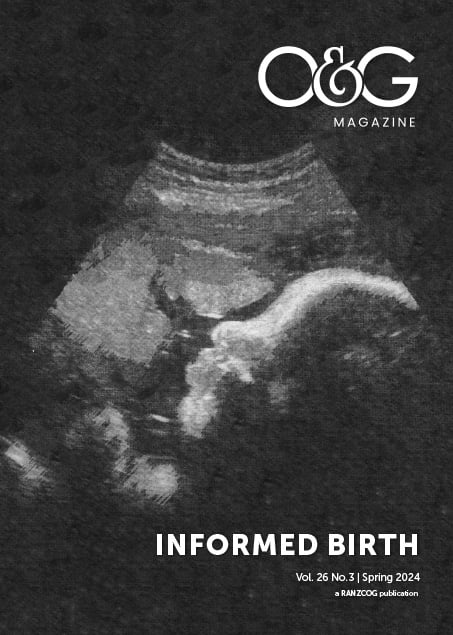Informed care in midwifery continuity
Continuity of Midwifery care (CoC) is widely recognised as the ‘gold standard’ of maternity care for women. The updated 2024 Cochrane review found CoC increases rates of spontaneous vaginal birth and decreases rates of instrumental and caesarean births, as well as more positive experiences throughout the pregnancy, labour, and postpartum continuum.1
A context of relationship-based CoC allows for a unique trust to evolve over the pregnancy between a woman and her midwife. There is an investment in the journey, experience and outcome for this woman and her family from the perspective of the midwife, and with that comes very deep reward and satisfaction, but it does not come without its challenges.
The 2023 Birth Experience Study explored women’s experiences of birth in Australia over the past five years.2 This is an important and relevant topic, particularly with the recent NSW Birth Trauma Enquiry. This study, along with the Birth Trauma report3 found that women, across models of care, desire relational maternity care founded on their unique needs, wishes & values. Undoubtedly, the limitations of time, system and staffing of the current mainstream maternity care impede on our ability to provide this.
As a result, many women who make decisions outside of typical maternity guidelines and recommendations seek their maternity care within a continuity model. In this context they can build rapport with their midwife, have meaningful discussions including sharing of evidence-based information, and know they are able to make their own informed decision and have it heard and respected.

Betty Holland auscultating the fetal heart rate during caseload client Andrea’s labour (Westmead Hospital, Sydney). Photo credit: Alisia Mason Photography
The Queensland Health guideline: “Partnering with the woman who declines recommended maternity care” includes flowcharts for discussion, documentation, and escalation for women declining recommendations, but the core underpinning conclusion of the guideline is that: “The woman continues to receive care within the parameters of her consent”.4 Though our team firmly believes in this principle, this partnership and responsibility of caring for those who go “against the status quo” is a large workload that falls largely on continuity midwives.
We are incredibly fortunate in the Caseload Midwifery program at Westmead Hospital to work highly collaboratively with our obstetric specialists. Our midwives each have a consultant they meet with weekly to consult and discuss their caseloads. This provides an extraordinary opportunity for learning for midwives and doctors alike who each learn to trust each other and work cohesively to deliver safe care that is centred around the woman’s individual needs.
Sometimes medical recommendations, while evidence-based and aimed to ensure the best possible outcome, are not accepted by the woman. The role of medical and midwifery staff is to appropriately counsel and inform the woman of the evidence, risks and benefits. Their role is not to make any decisions for her or coerce her into making the decision they feel most comfortable with. This can undoubtedly cause fear and anxiety for her care-providers, but our discomfort does not outweigh her right to autonomy to make her own informed decision.
According to the 2019 Human Rights in Childbirth Submission to the Australian Human Rights commission: “Full and informed consent is only given if the healthcare provider explains the health status of the woman and her foetus, and provides complete and unbiased evidence-based information regarding her healthcare options and its risks. It includes the option to decline treatment. The woman should be given time, without pressure, to consider her options and decide independently of any influence and she has the right to change her mind at any time. Despite the ethical and legal obligations of facility-based healthcare providers to obtain full and informed consent to medical procedures, it is rarely observed in practice in maternal health. We have found, in our work, that informed consent is not standard practice, and worse, women who attempt to refuse medical treatment are often badgered or bullied and some forced against their will to undergo procedures, including surgical interventions of their bodies”.5 This sentiment was echoed in the Birth Trauma Report following the parliamentary inquiry.
Take, for example, a woman who has had a previous 3B tear. The caseload midwife discusses the case with her consultant at their weekly sit-down consult meeting. Together they review the notes, the woman’s endoanal ultrasound and her current symptoms. The consultant recommends that if she wants another vaginal birth, she has an elective episiotomy to minimise the risk of a recurring major tear. The midwife discusses this with the woman- presenting evidence and a discussion of the risks and benefits of an elective episiotomy or another major tear. She declines an elective episiotomy antenatally, sees the consultant at 36-weeks for another mode of delivery discussion, where she is appropriately counselled again, and again declines. During labour, her midwife is already aware of her birth choices and preferences and the fact that she has not consented to an elective episiotomy unless it is otherwise indicated at the time of birth.
Perhaps this woman has an intact perineum following this birth, aided by the weeks of perineal massage she has done to familiarise herself with the sensation of crowning, or the trust-based communication between midwife and woman to control the slow birthing of the head. Or, perhaps, she has another third-degree tear requiring transfer to OT for repair, physiotherapy follow up and known possible long-term implications to her health.

Betty Holland with caseload client Andrea and her Husband Andrew in the Birth Unit at Westmead Hospital, Sydney. Photo credit: Alisia Mason Photography
Regardless of the outcome, this woman was appropriately informed of the risks and was listened to and trusted by her midwife. Her outcome, which to her care providers was not the desired outcome, was for her incredibly positive and un-traumatic. We must trust that while we have a high level of medical expertise, women should always be the experts of their own bodies, pregnancies and births. They are not ours to control- regardless of outcome.
Another example from my own professional career as a caseload midwife was a growth-restricted baby whose mother was declining an induction of labour. While we may not have agreed with her decision ourselves, my obstetric consultant and I worked together to share information and counsel this woman appropriately.
This involved negotiation around timing of birth; asking about an end-point for when the woman might consider an IOL and answering questions about alternative plans for monitoring. In this case, the woman felt incredibly convicted that she felt her baby was safe and needed more time in-utero and was very reassured by a consistent pattern of fetal movements. While I certainly might have slept better if I knew this baby was safely born earlier (since the EFW and AC measurements were each on the second centile and her fundal heights were also measuring concerningly less than gestational age), she felt comfortable having second daily CTGs, her weekly doppler studies were normal and her baby was moving according to their normal pattern.
While the responsibility for the wellbeing of this baby was not wholly on my shoulders, as the lead maternity carer in a CoC context we must be mindful of the weight of carrying these cases. Although we may believe in a woman’s right to make an informed decision, this does not prevent our fear of the worst outcomes in pregnancy, labour and birth, including the fear of litigation. Extensive discussion and support within my caseload team and utilisation of clinical supervision for debriefing were incredibly important for my personal and professional wellbeing when caring for women who were straying from medical recommendation.
In this case, after the initial recommendation by MFM to induce by 38 weeks, she spontaneously laboured at 40 weeks and had an uneventful birth of a very tiny but otherwise well baby, born on the second centile as predicted.
While this outcome could easily have been different for another case, woman, baby and midwife, our job is to inform of evidence, risks, benefits, recommendations, and alternatives. After hearing these things, clarifying preferences and asking necessary follow-up questions it is the woman’s choice to decide. We must then hear her decision and respect it. This is by no means easy, but particularly in a context of relationship-based care; and often in a context of previous birth-related trauma – this is always our role and responsibility.
Betty Holland, Clinical Midwifery Specialist 2, Caseload, PAPOOSE & Dragonfly Midwifery Practices, Westmead Hospital, Sydney.
References
- Sandall K et al. Are Midwife Continuity of Care Models Versus Other Models of Care for Childbearing Women Better for Women and Their babies? 2024.
- Pelak H, Dahlen HG, Keedle H. A content analysis of women’s experiences of different models of maternity care: the Birth Experience Study (BESt). BMC Pregnancy and Childbirth 2023.
- Select Committee on Birth Trauma. Birth Trauma. 2024
- Clinical Excellence Queensland. Guideline: Partnering with the woman who declines recommended maternity care. 2020.
- Human Rights in Childbirth/Australian Human Rights Commission. 2019.





Leave a Reply